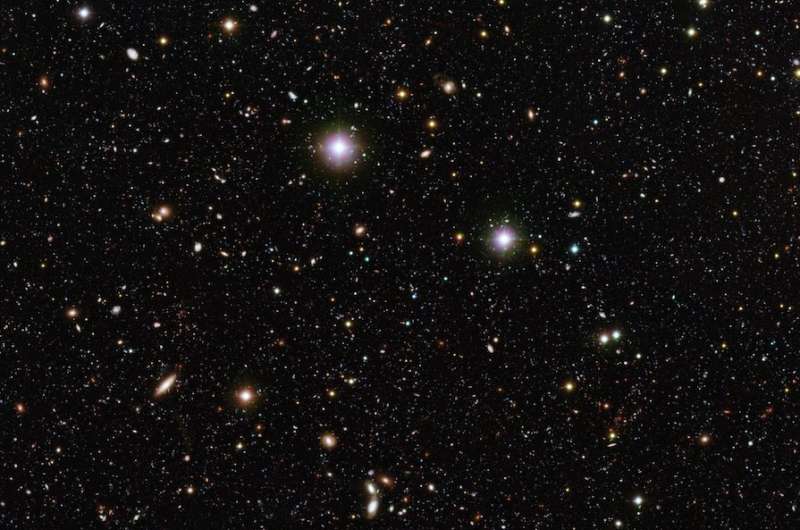An image of distant galaxies as seen by the VIMOS and WFI instruments on the ESO Very Large Telescope. Two different methods for determining the cosmic rate of expansion of the universe have reached precise but mutually inconsistent results. Astronomers had hoped that a third method that uses gravitational waves would be more accurate, but a new analysis shows that its uncertainties are about as large as in the other methods. Credit: ESO/ Mario Nonino, Piero Rosati and the ESO GOODS Team
Ninety years after Edwin Hubble discovered the systematic motions of galaxies and George Lemaitre explained them as cosmic expansion from a point using Einstein's equations of relativity, observational cosmology today is facing a challenge. Values deduced from the two primary methodologies—the properties of galaxies and the cosmic microwave background radiation (CMBR)—disagree with each other at roughly the ten percent level, yet each one is precise at the level of a few percent. Uncorrected observational errors are possible, but estimates suggest they are too small to account for the differences. As a result, no consistent and precise value of the expansion—Hubble's constant—has been found. The problem is not so much the value itself—the age of the universe will not change by much either way—rather, it is that something unexplained is clearly going on connected with the fact that the CMBR data arise from a vastly different epoch of cosmic time than do the galaxy data. Perhaps new physics is needed.
An exciting new and independent method of measuring the cosmic expansion parameter uses gravitational waves (GW). The observed intensity of the GW provides a measure of the distance since models can infer the intrinsic strength. When the GW results from a binary neutron star merger which has a detected optical counterpart, the host galaxy's cosmic recession velocity (as measured from its light) provides a calibration for the expansion rate. This new method is called the "standard siren." If the accuracy of the standard siren method is better than that of the other methods, it would be able to resolve the discrepancy.
CfA astronomer Hsin-Yu Chen has investigated the uncertainties associated with the standard siren method and finds that two issues complicate the standard siren method and pose major challenges to its resolving the tension. Both are related to the emitted light and the viewing angle of the source. The first problem is that the light is not emitted spherically according to computer simulations, and so the intensity we observe depends on our viewing angle; even the color is angle-dependent. The viewing angle must somehow be estimated and included in the calibration, and this carries an uncertainty. The second is that the merger event is also seen from a particular angle that affects the result; even after observing many sources, a statistical analysis of the sample will still have an uncertain bias. Chen concludes that these two systematic effects will introduce a bias in the standard siren value of Hubble's constant that results in its having an uncertainty that is as about large as the uncertainty in other methods.
More information: Hsin-Yu Chen. Systematic Uncertainty of Standard Sirens from the Viewing Angle of Binary Neutron Star Inspirals, Physical Review Letters (2020). DOI: 10.1103/PhysRevLett.125.201301
Journal information: Physical Review Letters
Provided by Harvard-Smithsonian Center for Astrophysics
























